Cake and the I-Cut-You-Choose Mechanic
The I-cut-you-choose game mechanic is most easily described by a simple analogy. There can be no peace in a house with two children and one piece of leftover birthday cake. That cake is a powder keg just waiting to be set off by the unjust distribution of desserts. “Your piece is bigger than mine! That’s not fair! I’m telling Mom!” Revolutions have been started over less.
I kind of drifted off in class, but I’m pretty sure the French Revolution had something to do with some lady’s cake.
Mom can resolve this!
Exasperated mothers everywhere have proposed a solution to this dilemma. It has proven successful enough that it has been incorporated as a mechanic in many board games, mostly by designers who were (I assume) the youngest children in their families: I cut and you choose. Big brother cuts the remaining cake into two pieces and little brother chooses the piece he wants. This gives the elder sibling the incentive to cut the pieces as equally as possible. …or maybe not.
If the cutter loves icing, how can he cut the pieces so that he can maximize his intake of butter and sugar? He could make the piece with the icing rose smaller than the other so that his brother will choose the bigger piece. But how much smaller does it have to be?
If you are the one choosing, how much icing are you willing to sacrifice for the larger piece? Is it worth taking the smaller portion just to get back at your brother for touching your Pokémon cards?
How does I-cut-you-choose play out in games?
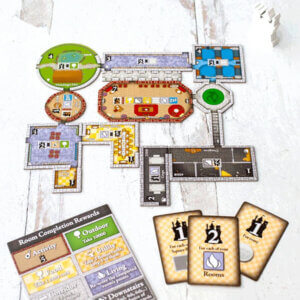
I-cut-you-choose games force you to consider making sacrifices. Your opponent has divided something—slices of pizza, diabolical gadgets, or castle chambers—into piles and you must choose the one that benefits you the most. Do you go for a high-scoring card even though it comes with a card that could penalize you?
As the player making the division, you also have difficult decisions to make. You want one of these cards to complete a set, but you don’t get first pick. How do you make the other pile appealing enough to the other player that she will choose it? That may require creating one pile of four cards and one pile with a solitary card—the one you want. Is that one card worth enough to you to give your opponent four cards?
Games using the I-cut-you-choose mechanic often combine it with the set collection mechanic. If your opponent made a pile worth 11 points and one worth 9 points, the choice would be easy.
The Set Collection Twist

Yet in set collection games, the value of an item is derived from belonging to a set. So, cards don’t have the same value to all players. If you have cards of that type, it’s valuable to you but not to your opponents—unless they are also trying to collect cards of that type. This makes the selection decision less obvious and more strategic.
It’s a simple mechanic, but it can lead to interesting choices. Not only are you seeking to complete your own objectives; you are also trying to second guess your opponents and predict how they will act. How will they respond to the incentives you offer?
I’ve cut down many options to a selection of five games that make the I-cut-you-choose mechanic central to the gameplay. It’s up to you to make the first pick. Mom said so.
1 New York Slice
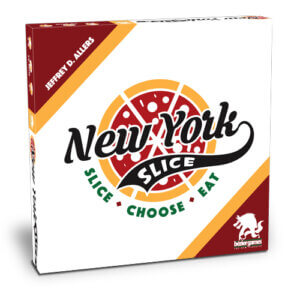
Few games embrace the I-cut-you-choose lifestyle as whole-heartedly as New York Slice.
Bezier Games fully commits to the pizzeria theme here. The pieces look like slices of pizza—even the back of the pieces, which look like crust. The game box opens like a pizza box, the manual looks like a menu, and the scorepad looks like the guest check.
Players take turns “slicing” pizzas. Eleven tiles are laid out in the shape of a pizza, and the slicer divides the pie into portions equal to the number of players. The other players choose their portions in player order with the slicer taking the leftovers.
Players can eat slices or keep them. Every piece of pepperoni eaten will give a point at the end of the game while every anchovy not eaten (eew!) subtracts a point.
Or players can choose to keep their slices. At the end of the game, the player with the most slices for each type of pizza will score the points for that type. If you have the most veggie slices, you score 3 points. But if you have majority in cheese slices, you add 11 to your score.
The theme of the game—slicing and serving pizza—perfectly suits the I-cut-you-choose mechanic. If you are in the mood for a quick, light game with challenging decisions, order a New York Slice.
2 Bequest
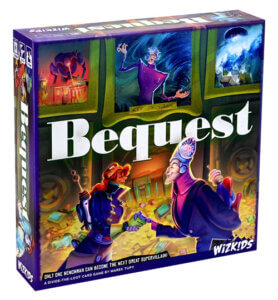
WizKids‘ Bequest is the newest game on this list. The sinister Dr. Schism has died, bequeathing his villainous assets to you—his minions—to fight over. The goal is to come away with as much of his ill-gotten fortune as possible.
Each player draws five Assets cards and divides them into two piles, offering them to a neighboring player. Players simultaneously choose one of the piles offered to them. They also keep the pile not chosen by their neighbor.
Key cards will allow you to take special Asset cards which provide in-game benefits as well as money. Gadget cards will score points if they are part of a set. Global Influence cards will earn money if you have more than your neighbors. But if you acquire too many Evidence Cards, you will lose points. After 5 rounds, the player with the most money wins.
Bequest is a good example of an I-cut-you-choose game that uses set collection. When you are choosing cards to offer your neighbor, you must consider what cards she has already collected as well as the cards you need. If you are competing for the same cards, it will be difficult to keep them without giving up a lot in return.
If set collection is your thing—and squabbling over an inheritance doesn’t hit too close to home for you—Dr. Schism has a Bequest for you.
3 Hanamikoji
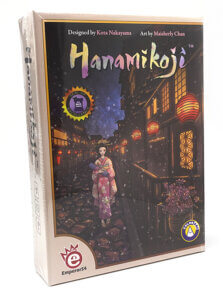
Convince the most charming geishas to perform at your restaurant in Hanamikoji, a 2-player game from Taiwanese publisher EmperorS4. You attract geishas by offering them the items they need to entertain, such as musical instruments and tea sets.
Players alternate turns, drawing items in secret, and taking one of four actions. When choosing the Gift action, the player plays three items face-up and the opponent gets to choose one of them. If you take the Competition action, play four items face-up in two piles. Again, your opponent gets to claim one of those piles for himself.
At the end of a round, when all four actions have been taken, a player will win the favor of a geisha if he offered her more of the required items than his opponent. If one player wins four geishas or geishas totalling 11 Charm Points, he wins.
Because some items are hidden and some are revealed, deducing which items your opponent is collecting is part of the challenge. Guess wrong and you may give up the last parasol he needs for a majority.
Hanamikoji: Geisha’s Road is a thematic sequel to Hanamikoji but features different gameplay.
The artwork is beautiful and games are quick. “OK, one more game” is something you will hear a lot with this on the table. If that attracts you, pay a visit to Hanamikoji, the street famous for its geishas.
4 Swordcrafters
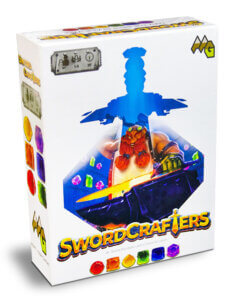
Draft and assemble cardboard tiles to forge the best 3D sword in Swordcrafters from Adam’s Apple Games. Each player makes a cut in a grid of 12 to 16 colored gem tiles, dividing one group of tiles into two. Then players will choose one of the groups of tiles and add them to their swords. The tiles slot together to create a sword that can be picked up and swung about in a reckless manner.
At the end of the game, players earn points for sword length, sword quality—measured by the largest set of adjacent gems on one side of the sword—and sword magic. Sword magic is the sum of two gem types determined by random goal cards chosen at the beginning of the game.
Swordcrafters is unique in that every player cuts a common set of resources, further dividing what has been divided by the players before her. The cutting and choosing decisions are interesting, but let’s be honest, the novel appeal of this game is wielding a cardboard sword you forged yourself.
You know you can’t resist that; just check out Swordcrafters.
5 Castles of Mad King Ludwig

Build the grandest castle for King Ludwig II in Bezier Games‘ tile-laying game Castles of Mad King Ludwig. Players purchase room tiles to add to their castles, scoring points for building rooms—including room connection bonuses—and completing public goals and private objectives.
The Master Builder for each round sets the prices for the available rooms. When other players buy the rooms, the Master Builder gets the money. She chooses last, so she could make her preferred room expensive so that other players can’t or won’t pay for it. But then she will have to pay that cost to the bank. Assuming she has the money for it.
Castles of Mad King Ludwig is primarily a tile-laying game, but tiles are drafted using the I-cut-you-choose mechanic. Much of the strategy in the game revolves around getting the right tiles to fit your castle, and you will have to price the tiles carefully so that you can buy the tiles you need without going broke.
It’s very satisfying to see your castle grow throughout the game. This is a good choice for those who like to build something in a game, whether it’s a farm, a spaceship, or a castle designed for a mad man (Who builds stairs to nowhere?) If that’s you, get to work on the Castles of Mad King Ludwig.
I Cut, Now You Choose
That’s my cut of the top games based on the I-cut-you-choose mechanic. It’s time for you to choose one.
Or five. Nothing in the rules says you can’t have your cake and eat it, too. But you’ll still have to share it with your brother.
Written by John David Thacker
John David is a freelance writer specializing in board games and the board game industry.

